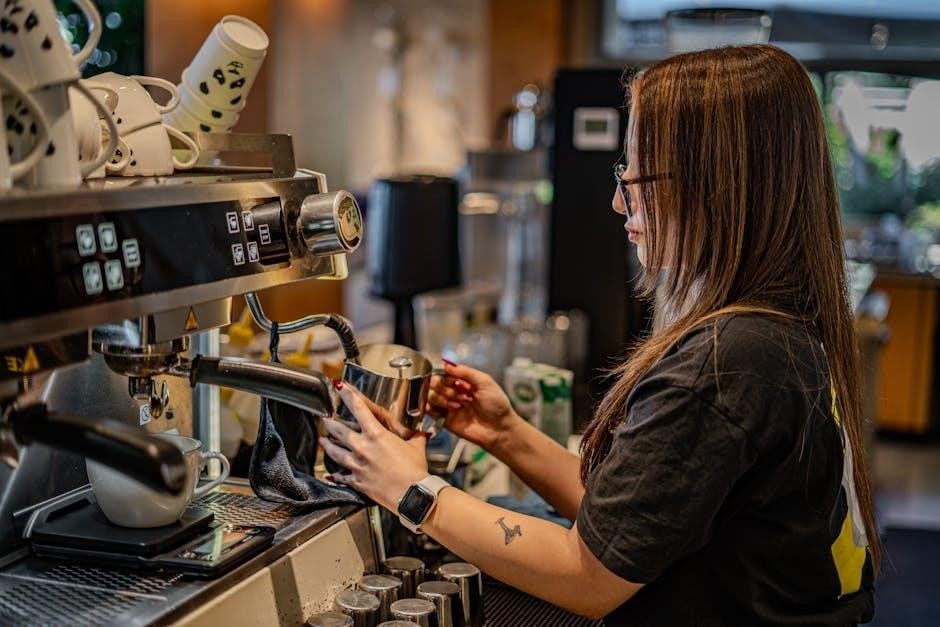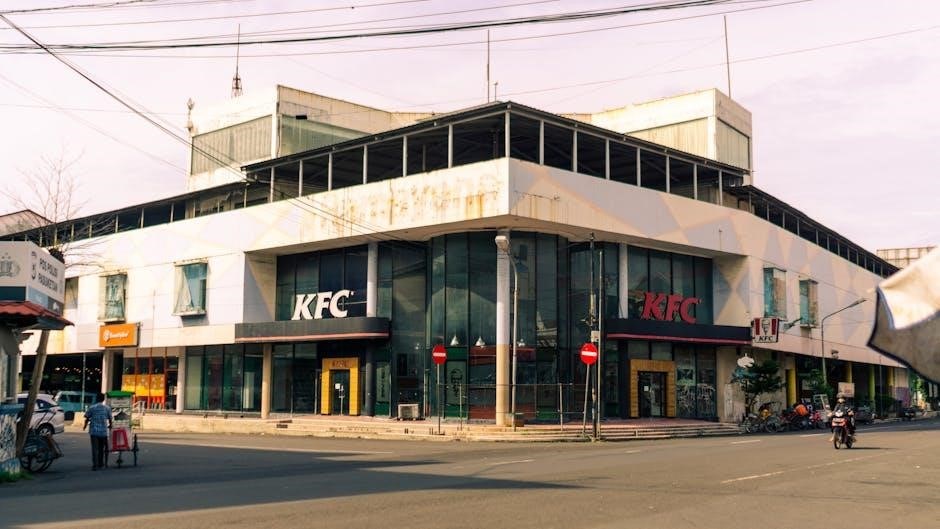
Executive Summary
A professional restaurant business plan is essential for success‚ outlining concept‚ target market‚ menu‚ financial projections‚ and branding strategies to attract investors and ensure long-term viability.
1.1. Overview of the Restaurant Concept
The restaurant concept revolves around creating a modern‚ inviting dining experience with a focus on high-quality cuisine and exceptional service. It emphasizes a casual yet sophisticated atmosphere‚ blending traditional flavors with innovative twists. The concept highlights seasonal ingredients‚ ensuring freshness and sustainability. This approach aims to cater to a diverse clientele‚ offering a memorable experience that combines culinary excellence with a welcoming ambiance‚ making it a standout destination for food enthusiasts and casual diners alike.
1.2. Business Objectives and Mission Statement
The restaurant’s mission is to deliver exceptional dining experiences by serving high-quality‚ innovative cuisine in a welcoming atmosphere. Objectives include achieving operational excellence‚ building a loyal customer base‚ and maintaining profitability. The establishment aims to source ingredients sustainably and support local suppliers‚ fostering community connections. By combining outstanding service with culinary creativity‚ the restaurant strives to become a trusted destination‚ ensuring customer satisfaction and long-term success in the competitive market.

Market Analysis
The restaurant industry is growing‚ driven by increasing demand for unique dining experiences. Understanding target demographics‚ market trends‚ and competitive landscapes is crucial for strategic positioning and sustainable growth.
2.1. Industry Overview and Trends
The restaurant industry is experiencing steady growth‚ influenced by changing consumer preferences. Health-conscious dining‚ plant-based options‚ and experiential eating are on the rise. Technology integration‚ such as online ordering and delivery services‚ is also transforming the sector. Additionally‚ sustainability practices are becoming key differentiators. These trends highlight the importance of adaptability and innovation for restaurants aiming to capture market share and meet evolving customer demands effectively.
2.2. Target Market and Demographics
The target market includes young professionals and families seeking high-quality‚ affordable dining options; Key demographics feature individuals aged 25-45‚ middle to upper-middle-class residents‚ and health-conscious diners who prioritize fresh ingredients. These groups align with the restaurant’s commitment to providing a welcoming ambiance and diverse menu options‚ ensuring broad appeal and fostering long-term customer loyalty and satisfaction.
2;3. Competitive Analysis
The restaurant will compete with local dining establishments‚ focusing on unique menu offerings and superior customer service. Direct competitors include upscale casual restaurants‚ while indirect competitors are fast-casual chains. Strengths of competitors include established customer bases‚ while weaknesses lie in limited menu innovation. By offering a distinctive ambiance and high-quality‚ locally sourced ingredients‚ the restaurant will differentiate itself‚ attracting food-conscious diners seeking a memorable dining experience.
Menu and Pricing Strategy
The menu features contemporary dishes using locally sourced‚ seasonal ingredients. Pricing strategy balances competitiveness with profitability‚ ensuring value for money while maintaining a premium dining experience.
3.1. Menu Development and Design
The menu is crafted to reflect the restaurant’s theme‚ offering a balance of classic favorites and innovative dishes. Seasonal ingredients ensure freshness and variety. Menu engineering focuses on high-margin items and customer preferences. The design is visually appealing‚ with clear sections and pricing transparency. Digital menus are also available‚ enhancing the modern dining experience while maintaining brand consistency and operational efficiency.
3.2. Pricing Strategy and Cost Analysis
The pricing strategy is designed to balance profitability and customer affordability. A value-based approach ensures menu items are competitively priced while reflecting quality and portion size. Cost analysis includes food‚ labor‚ and overhead expenses to determine optimal pricing. Prices range from $10 to $25 for main courses‚ with premium options for specialty dishes. This strategy aligns with target market expectations and maintains profit margins while fostering customer loyalty.

Restaurant Concept and Design
The restaurant features a modern‚ sleek design with a welcoming atmosphere‚ blending aesthetic appeal with functionality. The concept emphasizes a harmonious dining experience.
4.1. Theme and Ambiance
The restaurant’s theme revolves around a welcoming‚ modern dining experience with a rustic twist. The ambiance is created through warm lighting‚ soft background music‚ and earthy color schemes. Open kitchens and communal seating enhance the lively atmosphere‚ fostering social interaction. Natural materials like reclaimed wood and greenery add a cozy‚ organic feel. The design ensures a balance between comfort and sophistication‚ appealing to a broad demographic while maintaining a unique identity that aligns with the restaurant’s brand and culinary offerings.
4.2. Floor Plan and Layout
The floor plan is designed to maximize space efficiency while creating a seamless dining experience. The layout includes a main dining area‚ open kitchen‚ bar‚ private dining section‚ and outdoor seating. The flow between kitchen‚ service‚ and dining areas ensures smooth operations. Seating capacity is optimized for 50-70 guests‚ with adaptable layouts for intimate or group settings. Accessibility features‚ such as ramps and wide pathways‚ ensure inclusivity. The design prioritizes visibility‚ comfort‚ and functionality to enhance customer satisfaction and operational efficiency.

Business Structure and Management
The restaurant will operate as an LLC‚ ensuring liability protection for owners. A experienced management team will oversee daily operations‚ with clear roles for the General Manager and Head Chef.
5.1. Ownership Structure
The restaurant will operate under a Limited Liability Company (LLC) structure‚ offering liability protection for its owners. The ownership will be divided among three founding members‚ with equal shares of 33.33%. Each owner brings unique expertise: one in culinary arts‚ another in business management‚ and the third in marketing. Decision-making will follow a majority voting system‚ ensuring efficiency while protecting minority interests. This structure balances control and accountability‚ fostering a collaborative environment for long-term success.
5.2. Key Personnel and Roles
The restaurant will be led by a team of experienced professionals. The Executive Chef will oversee menu execution and kitchen operations‚ while the Restaurant Manager will handle day-to-day activities‚ staffing‚ and customer service. A Marketing Manager will develop and implement branding and promotional strategies. Additional key roles include a Sous Chef‚ Front-of-House Manager‚ and a Financial Controller. Each position is designed to ensure seamless operations‚ high-quality service‚ and sustained business growth‚ aligning with the restaurant’s mission and vision.
Financial Plan
The financial plan outlines startup costs‚ funding requirements‚ projected revenues‚ and break-even analysis. It includes a detailed profit and loss statement‚ ensuring sustainability and scalability.
6.1. Startup Costs and Funding Requirements
Startup costs include location acquisition‚ kitchen equipment‚ interior design‚ and initial inventory. Total estimated investment is $500‚000‚ with $300‚000 allocated to equipment and renovations. Funding sources include bank loans‚ investor contributions‚ and personal capital. A detailed breakdown of expenses and funding allocation is provided to ensure clarity and transparency for stakeholders. This section highlights financial requirements to establish a sustainable restaurant operation.
6.2. Revenue Projections and Break-Even Analysis
Revenue projections estimate $1.2 million in the first year‚ with a 10% annual growth rate for the next three years. The break-even point is projected at six months‚ requiring average monthly sales of $50‚000. This calculation assumes consistent occupancy rates and menu pricing. Detailed financial models outline revenue streams‚ ensuring stakeholders understand the restaurant’s path to profitability and sustainability in the competitive market.
6.3. Profit and Loss Statement
The restaurant anticipates a net profit margin of 8% in the first year‚ rising to 12% by year three. Annual revenue is projected at $1.2 million‚ with $900‚000 in cost of goods sold (COGS) and $200‚000 in operating expenses. Labor costs are expected to account for 30% of revenue‚ while occupancy costs will represent 15%. The P&L statement outlines these projections‚ ensuring clarity on profitability and financial health over the initial three-year period.

Marketing and Advertising
Focuses on building brand awareness through digital marketing‚ social media‚ and local promotions to attract diverse customer segments‚ ensuring consistent engagement and customer loyalty.
7.1. Branding and Logo Design
A strong brand identity is essential for differentiation. The logo will reflect the restaurant’s theme‚ using vibrant colors and typography to evoke appetite and warmth. Branding will emphasize quality‚ freshness‚ and uniqueness‚ aligning with the target audience’s preferences. Consistent visual elements across signage‚ menus‚ and packaging will reinforce recognition. The brand voice will be friendly and inviting‚ creating an emotional connection with customers. A well-designed logo and branding strategy will establish trust and loyalty‚ setting the restaurant apart from competitors.
7.2. Marketing Strategies and Campaigns
The restaurant will implement a multi-channel marketing approach to attract and retain customers. Digital marketing efforts include social media advertising‚ email marketing‚ and targeted online ads. Promotional activities such as happy hour specials‚ loyalty programs‚ and limited-time offers will drive foot traffic. Partnerships with local businesses and influencers will enhance visibility. Seasonal campaigns will align with holidays and local events to create buzz and attract diverse demographics‚ ensuring consistent engagement and customer loyalty.
7.3. Social Media and Online Presence
The restaurant will maintain a strong online presence through platforms like Instagram‚ Facebook‚ and Twitter. High-quality food images‚ behind-the-scenes content‚ and customer testimonials will engage followers. User-generated content campaigns will encourage diners to share their experiences. The website will feature online ordering‚ reservations‚ and a blog for recipes and stories. SEO optimization will ensure visibility in local searches. Google My Business will be updated regularly with menus‚ hours‚ and reviews to enhance credibility and attract new customers.
Operational Plan
The restaurant will implement efficient supply chain management‚ staff scheduling‚ and inventory systems. Training programs will ensure high service standards‚ and compliance with health regulations will be prioritized.

8.1. Supply Chain and Inventory Management
The restaurant will establish reliable relationships with local suppliers to ensure fresh‚ high-quality ingredients. Inventory management software will track stock levels‚ reduce waste‚ and optimize ordering. Regular audits will be conducted to maintain accuracy. Suppliers will be vetted for consistency and cost-effectiveness‚ with backup options in place to avoid disruptions. This system ensures efficient operations‚ supports menu consistency‚ and minimizes costs.
8.2. Staffing and Training
The restaurant will recruit qualified staff‚ including chefs‚ servers‚ and hosts‚ ensuring a skilled and friendly team. Comprehensive training programs will focus on customer service‚ food safety‚ and operational efficiency. Cross-training will enable staff to handle multiple roles during peak times. Ongoing training sessions will be conducted to maintain high standards and adapt to feedback. Incentives will be offered to retain top performers‚ fostering a positive work environment and ensuring exceptional customer experiences.
8.3. Legal and Regulatory Compliance
The restaurant will obtain all necessary food service certifications and adhere to health and safety regulations. Regular health inspections will be conducted to maintain high standards. Business licenses and permits will be secured‚ ensuring compliance with local laws. Employment laws‚ including fair labor standards and non-discrimination policies‚ will be strictly followed. The restaurant will also comply with fire safety codes and zoning requirements‚ ensuring a safe and legally operated establishment.

Risk Management
The restaurant will identify and mitigate risks such as market fluctuations‚ operational disruptions‚ and financial uncertainties. Strategies include flexible menu offerings‚ staff training‚ and contingency planning to ensure stability;
9.1; Potential Risks and Challenges
- Intense competition in saturated markets.
- Economic downturns leading to reduced consumer spending.
- Rising costs of ingredients and supplies.
- Labor shortages and high staff turnover.
- Compliance with health and safety regulations.
- Unexpected disruptions from events like natural disasters or pandemics.
9.2. Mitigation Strategies
To address potential risks‚ the restaurant will implement strategies such as diversifying revenue streams through takeout and delivery services‚ securing long-term supplier contracts to stabilize costs‚ and investing in staff training to reduce turnover. Additionally‚ the restaurant will maintain a contingency fund for economic downturns and develop a crisis management plan for unforeseen disruptions. Regular market analysis will help identify and adapt to competitive pressures‚ ensuring sustained growth and profitability.
Launch Plan
The restaurant will execute a phased launch‚ starting with a soft opening to test operations‚ followed by a grand opening featuring marketing campaigns and community engagement;
10.1. Pre-Launch Preparations
The pre-launch phase involves finalizing the menu‚ training staff‚ and testing operational systems. Key activities include securing necessary permits‚ conducting a soft opening for feedback‚ and ensuring all equipment is functional. Staff will undergo comprehensive training to align with the restaurant’s mission and service standards. Invitations will be sent to local influencers and VIP guests for a preview event. Feedback collected during this period will help refine operations before the official launch.
10.2. Grand Opening Strategy
The grand opening will be a high-impact event to attract attention and build customer loyalty. Activities include a ribbon-cutting ceremony‚ live music‚ and special promotions. A social media campaign will create buzz‚ offering limited-time discounts to first-week customers. Collaborations with local businesses and influencers will enhance visibility. The event will be promoted through email marketing‚ flyers‚ and targeted ads to ensure maximum turnout and a memorable experience that reflects the restaurant’s brand and mission.
Monitoring and Evaluation
Regularly track KPIs‚ customer feedback‚ and financial performance to assess progress and ensure goals are met‚ enabling data-driven decisions for continuous improvement and operational excellence.

11.1. Key Performance Indicators (KPIs)
Monitor sales growth‚ customer satisfaction scores‚ retention rates‚ and table turnover time. Track profit margins‚ labor costs‚ and inventory turnover. Regularly review online reviews and social media engagement metrics to gauge brand performance and customer loyalty‚ ensuring alignment with business objectives and identifying areas for improvement.
11.2. Continuous Improvement Strategies

Implement regular staff training workshops to enhance service quality and menu knowledge. Conduct customer feedback surveys to identify improvement areas and adjust operations accordingly. Invest in technology‚ such as POS systems‚ to streamline processes and reduce errors. Review menu offerings seasonally to ensure freshness and relevance. Allocate a budget for ongoing improvements and track progress through KPIs to ensure long-term success and customer satisfaction.

Future Expansion
Explore new locations‚ diversify menu offerings‚ and expand catering services. Consider franchising opportunities and partnerships to scale the brand while maintaining quality and customer satisfaction standards.
12.1. Growth Opportunities
Identify new markets and expand geographically to increase brand presence. Introduce innovative menu items and dietary options to attract a broader customer base. Explore partnerships with food delivery platforms and local businesses to enhance reach. Invest in technology‚ such as online ordering systems‚ to improve customer convenience. Consider franchising opportunities to scale operations while maintaining brand consistency. Regularly assess consumer trends to adapt and stay competitive in the evolving market landscape.
12.2. Long-Term Goals and Vision
Aim to establish the restaurant as a market leader in the dining industry‚ known for exceptional quality and customer satisfaction. Envision expanding the brand’s presence through strategic locations and franchise opportunities. Focus on creating a memorable dining experience that fosters loyalty and community engagement. Commit to sustainability and ethical sourcing of ingredients. Strive to innovate continuously‚ staying ahead of culinary trends while maintaining a strong connection to the restaurant’s core values and mission.